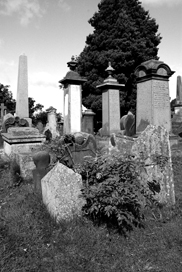John Macfarlane of Coneyhill
Philanthropist
1785 – 1868
One of the more colourful characters in this graveyard is John Macfarlane.
John Macfarlane was born in Stirling in 1785. He became a merchant and made his fortune in Glasgow and Manchester, but settled in nearby Bridge of Allan when he retired. A keen natural historian, he built, equipped and filled a Natural History Museum in 1843 entirely at his own expense; in 1887, several years after his death, a new Museum Hall was built from Macfarlane funds which served the dual purpose of housing the ever-growing Natural History collection and of providing a local concert hall. The collection was broken up in the 1930s, but the hall continued to be the cultural centre of the area until subsidence forced its closure in 1979. Among the more famous performers to grace the Museum Hall stage were the Beatles, who appeared there in 1963. The shell of the Museum Hall still stands opposite the Pullar Memorial Garden in Bridge of Allan and currently is scheduled for redevelopment.
In 1855 John Macfarlane established a Free Library in Stirling. He also contributed liberally to the funds to build the High School of Stirling and, as one of the original proposers, subscribed handsomely to the National Wallace Monument fund. A staunch supporter of the Stirling regatta, he conceived plans to provide gondolas on the River Forth, to open tea gardens at Cambuskenneth, to establish a school of design for local artisans, to enlarge Stirling Harbour, and to build a suspension bridge from what is now Corn Exchange Road to Cambuskenneth. None of these plans were realised, nor was his ambitious scheme to open a ship canal between Dunmore and Loch Lomond. In John Macfarlane’s view, these would have provided inestimable benefits to Stirling but, like John Macfarlane himself, his visions were ahead of their time.

